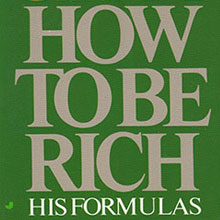Article by Investment U

J. Paul Getty’s book, How to Be Rich, was recommended by Mark Ford in a recent column. In fact, he advised that even if you've already read it, read it again.
Upon seeing the first chapter entitled How I Made My First Billion, I knew I had a winning book in my hands…
J. Paul Getty’s book, How to Be Rich, was recommended by Mark Ford in a recent column. In fact, he advised that even if you’ve already read it, read it again.
So I promptly ordered it and read it twice in one week.
What a fantastic book. Getty’s life story alone is inspiring, but what makes it special is his blunt and personal advice.
Getty was fortunate to have oil and common sense in his blood in equal proportions.
His father was a successful businessman who moved west to become a wildcatter in the rough and tumble Oklahoma oil boom. J. Paul grew up around the business doing the tough and gritty work at the wellhead before striking out on his own.
With no capital at all, the first deal for this independent wildcatter gave him a 15% share of the profits. Then his father grubstaked him, taking 70% of the profits while the Oxford-educated son worked right next to the roustabouts with his battered car serving as his office.
By the age 24, he became a millionaire. His next move was to explore for oil in California where his success expanded into property and stocks.
What makes this book different is that it isn’t just about how to get rich, but how to live a full and rich life. In Getty’s view, the key is to be a non-conformist, to be independent and willing to challenge conventional wisdom.
After reading the first chapter, I had a tremendous urge to jump out of my chair and dig for oil in my backyard. (I settled on just planting a tree.)
Taking on Getty’s Life Lessons
The Getty story pulsates with activity, nerve and initiative. Here’s my take on Getty’s life lessons and how they can be applied to become a more successful investor and businessperson.
Be stealthy – Getty won his first oil property in a competitive bid for only $500 by using a bank as his proxy, thereby scaring away independent competitors.
Separate fact from opinion – Getty always tried to dig deep for facts and challenge “expert” opinions. He was one of the few wildcatters who studied and used geological data to help him make decisions.
Be independent – Getty loved being an independent wildcatter outwitting the big boys. It’s hard to imagine him sitting in a cubicle, or any office, for that matter.
Look ahead and learn from mistakes – Getty was way ahead of his time in seeing great growth opportunities in international markets. Half a dozen times in his book, he literally kicks the reader to look beyond America’s borders. And Getty doesn’t pass the buck, but admits his blunders. One beauty was to pass on a bargain-basement opportunity to gain a foothold in the oil-rich Middle East in the 1930s only to pay $12 million for a Saudi concession in 1946. (Still a great move.)
Be patient, but take risks in down markets by finding quality values – Getty was a master in taking advantage of great stock values in depressed and crisis markets. Much of his great fortune can be traced back to the 1930s when he scooped up resource stocks and properties at bargain prices.
Finally, Getty chose his targets carefully and had the courage of conviction to jump in when others were scared to death. He put it this way:
”The big profits go to the intelligent, careful and patient investor, not to the restless and overeager speculator… The seasoned investor buys stocks when they are low, holds them for the long-pull rise and takes in between dips and slumps in his stride.”
All great lessons and reminders to investors and businessmen of any skill level…
Good Investing,
Carl Delfeld
Article by Investment U